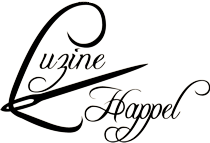Das lange Band ist fertig. An der Wand hängend sieht es schön aus, aber auch auf meinem großen Tisch liegend gefällt es mir gut. Leider lässt es sich in voller Länge nur sehr schwer fotografieren.
Daher folgen hier noch einmal alle Abschnitte von oben nach unten.
In der Wäsche sind Garn und Leinen geschrumpft. Erst dadurch erhielten die Flächenfüllmuster ihr endgültiges Aussehen und ihren speziellen Effekt.
Durch das Bügeln von der linken Stoffseite aus und auf einer dicken, weichen Unterlage platziert konnten sich Stiele, Spiralen, Blättchen usw. in die Unterlage drücken. So hebt sich jetzt sich die komplette Oberflächenstickerei plastisch vom Leinen ab.
Dadurch wird der für die Schwälmer Weißstickerei so typische und charakteristische Gegensatz von Durchbruchstickerei und Oberflächenstickerei erzielt.
Denn die erhabenen kleinen Elemente kontrastieren zu den eher flach wirkenden Flächen der großen Motive.
Viele Bestandteile der Schwälmer Weißstickerei wurden in diesem Projekt angewendet:
Stiele mit Abzweigen
Spiralen
gerundete und spitze, geteilte und ungeteilte Blättchen
Schnürlöcher
kleine Blümchen und andere vegetabile Elemente sowie kleine Herzen
Wimpernstiche
Schnürlochbögen und geschnürte Bögen
2kurz-2lang
Messerspitzen und Schlingstiche
einfache Durchbruchmuster
Limet-Durchbruchmuster
lichte Durchbruchmuster
einige Füllungen ohne Fadenauszug aus dem Bereich der frühen Schwälmer Weißstickerei und
eine Nadelspitzenfüllung.
Natürlich kann man die Stickerei besonders im Bereich der Flächenfüllmuster ganz anders gestalten. Mein Anliegen war es jedoch, möglichst viele verschiedene Muster zur Anwendung zu bringen.
Schwälmer Band – Konturenmuster
Schwälmer Band (1) Musterübertragung
Schwälmer Band (2) Vorbereitende Arbeiten von Abschnitt 5
Schwälmer Band (3) Vorbereitende Arbeiten von Abschnitt 4
Schwälmer Band (4) Vorbereitende Arbeiten von den Abschnitten 3 – 1
Schwälmer Band (5) – Füllungen von Abschnitt 5 II
Schwälmer Band (6) – Füllungen von Abschnitt 5 I
Schwälmer Band (7) – Füllungen von Abschnitt 4 b II
Schwälmer Band (8) – Füllungen von Abschnitt 4 b I
Schwälmer Band (9) – Füllungen von Abschnitt 4 a II
Schwälmer Band (10) – Füllungen von Abschnitt 4 a I
Schwälmer Band (11) – Füllungen von Abschnitt 3 II
Schwälmer Band (12) – Füllungen von Abschnitt 3 I
Schwälmer Band (13) – Füllungen von Abschnitt 2 II
Schwälmer Band (14) – Füllungen von Abschnitt 2 I
Schwälmer Band (15) – Füllungen von Abschnitt 1 II
Schwälmer Band (16) – Füllungen von Abschnitt 1 I
Schwälmer Band (17) – Fertigstellung











Luzine this is simply magnificent ! The relief created by the raised elements puts it at a higher level.
A question for you: I have just read that Anchor is discontinuing the white thread in all sizes except 25. Did you hear this ? If so, it would be time to stock up on 16, 20 and 30 weights.
Danke, Heather!
Yes, unfortunately it is true. MEZ Anchor company was sold to DMC France. When I got to know itin the beginning of August, I tried to order threads for my stock. First they told me that I would receive the threads I ordered but were currently unavailable from DMC later. But then they said, I would have to order newly. I got an order list. There was only listet coton à broder No. 25, marked with a star – this means, available only while stocks last.
Later we have to order DMC. I asked for a DMC list, but got no answer so far. It’s a shame that the range of materials for Schwalm whitework and also other embroideries is increasingly being reduced. First the linen, now the threads.
I’m sorry I don’t have anything better to say
That is such a shame!
I was shocked and it is also true that DMC does not make the range of sizes any more either. So what is the best course of action ? I will see if I can still order some current stock, but going forward, what would be the best alternative ? Do you think perle cotton or similar ? Or six-stranded floss ?
I am glad to say that I stocked up on linen (as you know !) because I could already see a time when it would no longer be manufactured.
Now and then one can find some skeins of different weights in online shops and on ebay. But it is hard to collect sindle or only couples of skeins. Shipping makes them expensive.
Yesterday I met a man – an embroiderer. Because he could no longer get coton à broder in the local needlework shop, he started to use stranded cotton. I divedes the six-ply floss and takes as many of them as he needs to create different weights He twists them a little bit together and so stitching with these threads is no problem.
So I think to use stranded cotoon is better than perle cotton.
Yes, I thought something like that would be possible. Also I thought about the DMC cordonnet which comes in so many thicknesses, I have some 80 which is very fine, but they have all from 10-100. It is corded so that could either be helpful or not. Might be worth a try.
Isn´t crochet cordonnet not too hard twisted?
So far I only used it for Peahole hems, nerver for surface embroidery.
Your work is absolutely divine!!! I am in awe in front of such work and beauty. No word comes to mind to really express my admiration for your work. You are the best!!!